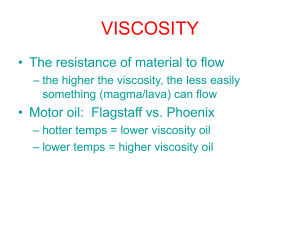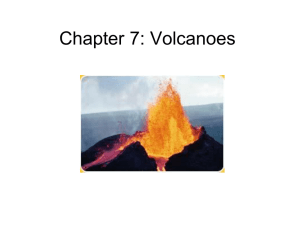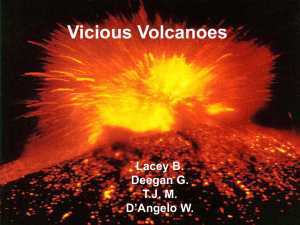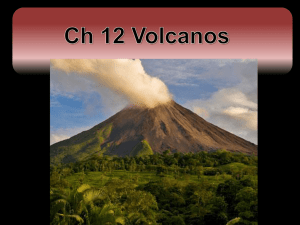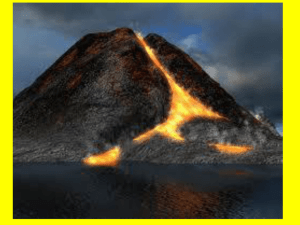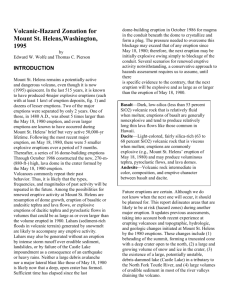18.3 Volcanoes
advertisement
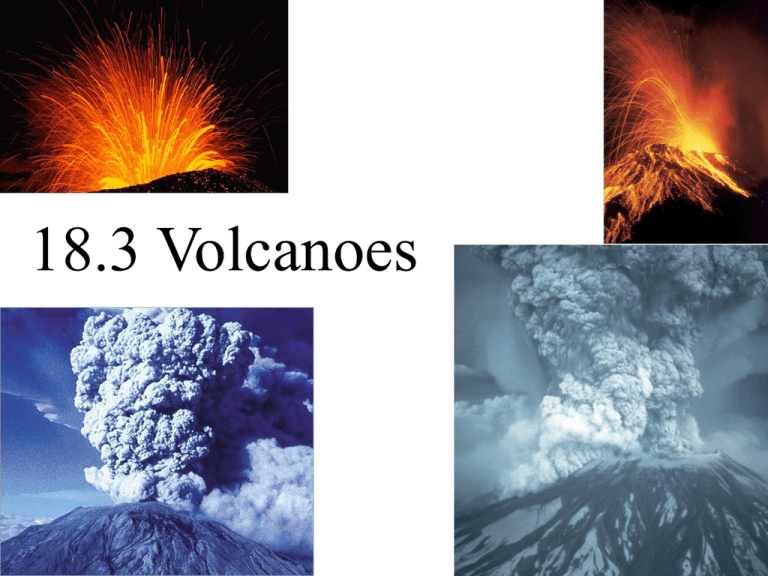
18.3 Volcanoes When magma reaches Earth’s surface it is called lava. Objectives • Describe the major parts of a volcano. • Compare and contrast shield, cinder-cone, and composite volcanoes. • Contrast the volcanism that occurs at plate boundaries. • Explain the relationship between volcanism and hot spots. Vocabulary – – – – vent crater caldera shield volcano – – – – – cinder-cone volcano composite volcano tephra pyroclastic flow hot spot • A crater is a bowl-shaped depression at the top of a volcano that is connected to the magma chamber by a vent. Tephra are rock fragments thrown into the air during a volcanic eruption. • A vent is where lava erupts through an opening in the crust. Calderas • Calderas are large depressions that can form when the summit or the side of a volcano collapses into the magma chamber. Volcanoes Three main types: Shield Composite Cinder Cone Shield • Very fluid lava- has Iron (Fe) and Magnesium (Mg). • Lava flows great distances • Mild eruptions • Gentle sloping • Some of the largest volcanoes in the world Shield Volcano Mauna Loa - Hawaii Composite • Made up of alternating layers of ash, cinders and lava • Lava rich in silica (Si) • Lava thick • Eruptions can be explosive • Steep slopes Composite Mt Fuji Japan Cinder cone • • • • • • Smallest volcano type Most abundant type Lots of gas trapped in magma Very explosive eruptions Active for only a short time Has bowl shaped crater in the center Cinder Cones Crater Lake Lava Flow Where do volcanoes occur? – 80% found at convergent boundaries. – 15% found at divergent boundaries. – 5% found far from plate boundaries. Where do volcanoes occur? Mediterranean Belt. Pacific Ring of Fire. Ring of Fire Hot Spots – Hot spots are unusually hot regions of Earth’s mantle where high-temperature plumes of mantle material rise toward the surface. – A plume does not move laterally, which results in a trail of progressively older volcanoes that formed as a plate moved over a hot spot. Hot Spot Plumes Pyroclastic Flows – A pyroclastic flow is Sakura-jima a cloud of volcanic gas, dust, and other tephra traveling at speeds of nearly 200 km/h. The center of a pyroclastic flow can exceed 700°C. Soufriere Hills Mt. Saint Hellens Pinatubo Ash Deposit Pyroclastic deposits • Over 100 pyroclastic fall deposits in Oshima on the Izu Islands Section Assessment 1. Match the following terms with their definitions. A. an opening in the crust from A vent ___ C crater ___ D tephra ___ E pyroclastic flow ___ B ___caldera which lava flows B. depression caused by a collapsed magma chamber C. a bowl-shaped depression around an opening in the crust D. volcanic materials that are thrown into the air during a volcanic eruption E. a cloud of rapidly moving, extremely hot volcanic material Section Assessment 2. How can chains of volcanoes that form over a hot spot track plate movement? The hot spot is in a fixed location. All of the volcanoes in the chain were over the hot spot when they formed. The volcanoes’ movement and the direction of the chain’s alignment indicates the movement of the plate. Section Assessment 3. Identify whether the following statements are true or false. true Many cinder-cone volcanoes are less ______ than 500 m high. false Volcanism is more common along divergent ______ boundaries as compared to convergent boundaries. false ______ The Mediterranean Belt is also known as the “Ring of Fire”. true ______ It can be 700ºC in the center of a pyroclastic flow. If Yellowstone Erupted Miscellaneous Info • Underwater volcano is called a seamountthey look a lot like composite volcanoes. • Most volcanoes occur at plate boundariesconvergent plate boundaries. • Volcanoes can occur in the middle of tectonic plates- these are called hotspots. Ex. Hawaiian Islands




